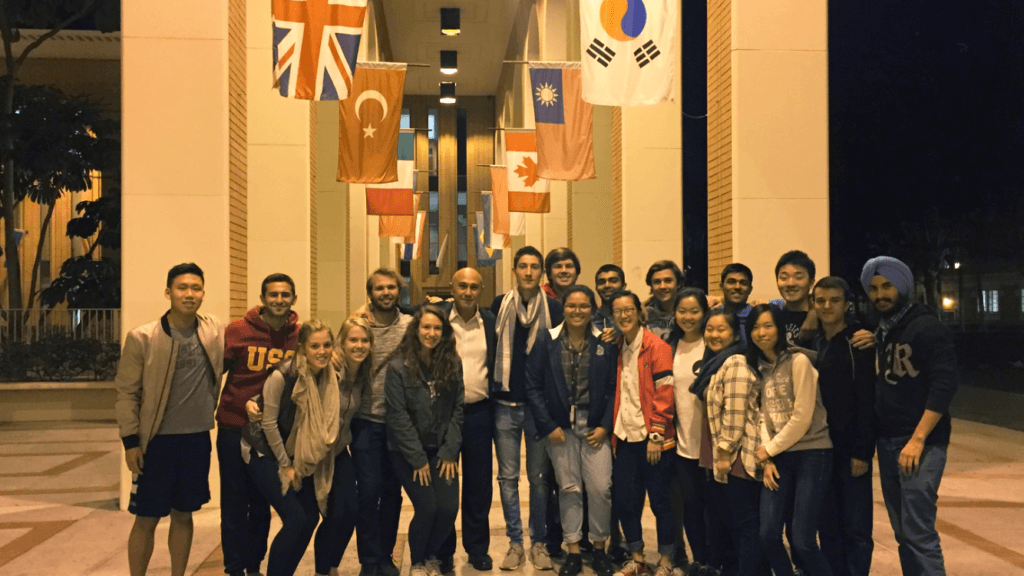Training for a 21st-Century Diplomacy
A new catchphrase is circulating on campus: engineering diplomacy.
It first showed up in a recurring dream of Najmedin Meshkati, a professor in the Sonny Astani Department of Civil and Environmental Engineering with joint appointments in the Daniel J. Epstein Department of Industrial and Systems Engineering and the USC School of International Relations. In his dream, Meshkati pondered, What if engineers made excellent diplomats? Conversely, what if diplomats were trained to think like engineers?
Those questions inspired Meshkati to create an engineering-diplomacy course that was offered at USC last fall. A freshman general education seminar open to all majors and offered in partnership with the USC Dornsife College of Letters, Arts and Sciences, it intends to equip the next generation of techno-diplomats to engineer meaningful change in the world through “a systems-oriented interdisciplinary thought process” — a key ingredient in problem-solving and analysis.
A new era of science diplomacy
Meshkati sees this approach as not only critical for navigating the treacherous waters of diplomacy but also for successful project design and execution on a global scale.
“In recent years science has played a renewed role in the broader U.S. foreign policy tool kit,” said Meshkati, who was a Jefferson Science Fellow and a Senior Science and Engineering Advisor under former Secretary of State Hillary Clinton.
“The term ‘science diplomacy’ often elicits images of cooperation in basic research or academic exchanges. But there is so much we can learn from modern engineering projects that are multinational and highly interdisciplinary to bridge the divides between countries,” he said.
More than half of the world’s population can now simply reach in their pockets to be informed, be in touch and manage their lives. But the same internet that unites families and businesses also allows drug lords and cyber criminals to prosper. Violent extremists effectively use social media and increasingly gain access to advanced destructive technologies.
Partnering with the State Department
Engineering Diplomacy students had to confront these global challenges from day one. Meshkati divided them into groups and assigned them the task of choosing a “wicked problem” from one of the 14 Grand Challenges issued by the National Academy of Engineering, the U.N.’s Sustainable Development Goals, or from among a lengthier list put forth by the State Department. Topics included water diplomacy, virtual reality, artificial intelligence, weapons of mass destruction, nonproliferation, counterterrorism, nuclear energy, climate change, oceans and the high seas, food security, conflict resolution, and emergency response to a major coastal disaster in the Persian Gulf.
Engineering and technology are empowering practically every aspect of our lives. Diplomacy has been largely absent from this convergence, but the opportunities are there for such an empowerment. – Yannis C. Yortsos
The goal was to submit proposals for consideration to the State Department’s Diplomacy Lab, a public-private partnership that enables America’s diplomats to “course-source” research and innovation from students and faculty across the United States.
Freshmen Emily Jin, who’s studying computer science, and Abegayle De Castro, majoring in civil engineering, considered water diplomacy between India and Pakistan under the current Indus Water Treaty, one of the most successful water-sharing endeavors in the world despite being riddled with conflict.
“Our proposal uses engineering diplomacy to mitigate the tensions between India and Pakistan, especially when it comes to the contested Kashmir region, and to reduce the environmental footprint of both nations,” De Castro said.
Chemical engineering major Brandon Reznicek and Noah Silver, who is studying international relations and human security at USC Dornsife, created interactive maps of the sites housing the world’s weapons of mass destruction, including the location and distribution of biological weapons.

Daniel Seaman, a music performance major at the USC Thornton School of Music, and Diego Ochoa-Cota, an aerospace engineering major, envisioned an international AI agency.
“There is no doubt that artificial intelligence is beginning to challenge the superiority of its human creator,” Seaman and Ochoa-Cota wrote in their proposal, “Let’s imagine that the world’s engineers and politicians create an AI agency to help regulate AI development but also to improve relations between countries.”
Senior Mustafa Mert Sezgen, who’s studying systems engineering, submitted a plan to enhance the nuclear safety culture in the Black Sea region, and got the chance to pitch it to senior diplomats in Washington.
“The great thing about this course is that at the end of their first semester at USC, freshmen students have a concrete product they can carry with them throughout their college careers and beyond,” said Mert Sezgen, who was Meshkati’s teaching assistant.
I am an engineer by training. I seek to understand the facts, follow where they lead, and apply logic to our international affairs. – Rex Tillerson
Civil engineering major Marco Valero, who along with psychology major Jianing Yao researched urbanization and food security, described engineering diplomacy as “a more evolved form of diplomacy, because it doesn’t rely on sociopolitical agreements and conflicts, but puts its faith in a universal platform all parties can agree on — scientific knowledge and advancement.”
International cooperation based on science and technology is rapidly becoming a key dimension of foreign policies in a number of nations, so bright, shining careers could await these fledging engineer-diplomats.
A new cadre of techno-diplomats
In 2015, the National Research Council of the National Academies put out an official recommendation to the State Department in a report titled “Diplomacy for the 21st Century: Embedding a Culture of Science and Technology Throughout the Department of State.” The report called for an increase in the cadre of foreign service officers with technical backgrounds and engineering training for such officers, “including assignments to positions that focus on science and technology issues.
Meshkati points out that there are thousands of people overseas who belong to American science, engineering and medical professional societies. For example, the Pasteur Institute for biological research has locations in Europe, the Middle East and Africa. Several global networks of institutes, such as the USC Information Sciences Institute (ISI), are linked through joint efforts to strengthen international capabilities for research and information exchange.
“These institutes provide important mechanisms for international engagement of scientists and engineers to stay abreast of global advances in their fields,” Meshkati said.
Engineering diplomacy will likely take on a life of its own at USC because, as former Secretary of Energy Ernest Moniz has said, “No amount of politics can override the laws of physics,” and because engineering is increasingly becoming a critical language in diplomatic missions — a theory that may be put to the test now that a former civil engineer, Rex Tillerson, is taking the helm at the State Department.
Tillerson signaled this mind-set in his opening remarks during his Senate confirmation hearing: “I am an engineer by training. I seek to understand the facts, follow where they lead, and apply logic to our international affairs.”
USC Viterbi Dean Yannis C. Yortsos believes engineering diplomacy is yet another manifestation of what he calls Engineering+, a philosophy that permeates the school’s curriculum.
“Engineering and technology are empowering practically every aspect of our lives. Diplomacy has been largely absent from this convergence, but the opportunities are there for such an empowerment as science and diplomacy become increasingly connected,” Yortsos said.




